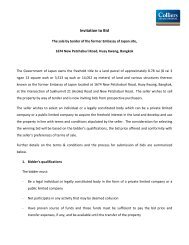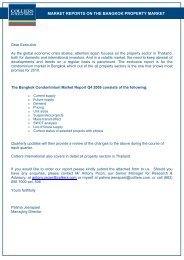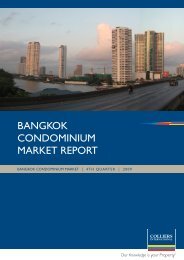CUBIC CoverDec08.indd - Colliers
CUBIC CoverDec08.indd - Colliers
CUBIC CoverDec08.indd - Colliers
You also want an ePaper? Increase the reach of your titles
YUMPU automatically turns print PDFs into web optimized ePapers that Google loves.
ANTI-CLOCKWISE FROM LEFT:<br />
Transcient, Suspense, The Watcher,<br />
Watergarden<br />
ART SCENE<br />
A QUICK LOOK INTO HISTORY reminds us that being an artist at one<br />
time was a job like any other, and the world’s great artists (Michelangelo,<br />
Picasso, Delgado) were often commissioned to create paintings and<br />
sculptures for public spaces.<br />
Often those were churches and rulers’ palaces but, later, those<br />
spaces began to include government structures, educational institutions,<br />
pedestrian shopping districts and eventually office complexes.<br />
Some of the greatest single works of art are in public spaces. The<br />
glorious frescos of the Sistine Chapel were a commissioned public piece;<br />
British sculptor Henry Moore is renowned largely for his public works;<br />
and Banksy blurred the distinction between public art and graffiti with his<br />
irreverent humour.<br />
Enormous canvasses now dot corridors, atriums and lobbies in<br />
commercial buildings all over the world, and works by contemporary artists<br />
can be found in the unlikeliest of locations. Until recently, art has not been<br />
a driving force in commercial design in Asia, but that’s starting to change<br />
and Swire Properties is leading the way.<br />
Swire Properties is the wholly owned real estate subsidiary of Swire Pacific,<br />
one of Hong Kong’s oldest trading companies with roots dating back to the<br />
early 1800s, and whose larger holdings also incorporate aviation (Cathay<br />
Pacific), marine services (Swire Pacific Ship Management), industrial and<br />
agricultural trading (TaiKoo Sugar) and beverage processing (Swire Coca-Cola).<br />
Incorporated in 1972, Swire Properties has built a portfolio that<br />
spans commercial, residential and retail properties, and has developed or<br />
manages some of Hong Kong’s most notable addresses: Island East, Pacific<br />
Place and Festival Walk.<br />
It’s no secret that writer James Clavell based one of the “houses” in<br />
Noble House on Swire. Swire currently has interests in the US, the UK,<br />
Singapore, Taiwan, Australia, Canada and China.<br />
DRIVING ART<br />
Swire has long been at the forefront of the public art movement in Hong<br />
Kong. Not only does the group often include art in its spaces and support<br />
independent exhibitions, but also Island East has long been the location for<br />
free outdoor concerts on weekends – Friday Fest – the company founded<br />
Artwalk in 2002 and has sponsored countless theatrical and music events<br />
over the past decade.<br />
There are many that would say art is a waste of time and (particularly<br />
public) money, but Swire disagrees, as would anyone strolling through the<br />
halls of Island East (home of TaiKoo Place) who caught a glimpse of Hong<br />
Kong artist Michael Lau’s stunning Watergarden series. “Swire Properties<br />
consciously connects its properties with the surrounding environment and<br />
visual art serves as one of the bridges for this initiative,” explained Babby<br />
Fung, Head of Marketing at Island East Swire Properties Limited. “Our aim<br />
is to produce an innovative and creative environment for the community<br />
and engage with the people in it via lively and diverse arts programmes and<br />
public art collections that provide enjoyment and fresh cultural experiences.”<br />
Some of those fresh experiences are coming from China, as there is<br />
very “strong demand” for Chinese contemporary art, in the Asia region<br />
and the Western art market, observed Bobby Mohseni, Director of MFA<br />
Asia Ltd, a Hong Kong art consultancy that serves both individual and<br />
corporate clients.<br />
Far from being a “waste” of public money and space, Fung points<br />
out that art doesn’t necessarily belong in museums and galleries and was<br />
never intended to be concealed from public view – Shakespeare was,<br />
after all, a playwright who catered to popular themes. Instead, at a time<br />
of great artistic diversity and shrinking public funds, Fung noted that the<br />
nurture and promotion of art is a corporate social responsibility that more<br />
corporations should take on. “We take the view that art, or public art, is<br />
not something that should be left entirely in the hands of governments.”<br />
The private sector has to be more active and a sustained commitment to<br />
commissioning diverse modern art is important, so that we form an eclectic<br />
collection in which a number of wide-ranging aesthetic, functional and<br />
educational purposes co-exist,” she added. Among some of Swire’s more<br />
notable pieces are figurative sculptor David Williams-Ellis’s The Watcher and<br />
glass sculptor Danny Lane’s Shan Shui, both sculptures also at Island East.<br />
The latter makes waiting for a taxi just a little bit more pleasant.<br />
THE VALUES OF BEAUTY<br />
Does art in fact make a noticeable difference to property values? There<br />
are naysayers, but Fung sees value in art. “For a value-creating business<br />
like ours, it is important to ensure that our goods and services are clearly<br />
differentiated and that they do not compete as commodities traded solely<br />
on price,” she said. “We have developed first-class properties in tandem<br />
with discriminating audiences who, through exposure to the arts or art,<br />
are able to recognise excellence and quality, and appreciate the values that<br />
| January 2009 15













